#also the costumes are 2009 unbearable but so it goes
Explore tagged Tumblr posts
Text
More Felix Scott

Been watching Missing (2009 UK TV series). There's only 15 episodes, but Felix Scott is third billed and in every episode (and even has a romance!). It's a pretty average TV procedural (I don't watch many though, so maybe I just don't know how it stacks up). Set in Dover. Felix is a detective in the Missing Person's Unit. But the best part is his boss is Pauline Quirke, AKA DIXON FROM NORTH AND SOUTH! It makes me laugh when she scolds him.
#felix scott#scarnash#using the scarnash hashtag so someone will see this post lol#I know i am in so deep for this man right now that I've dug up this show#did anyone watch this? i can't find much online about it#to be fair the title of the show is very bad for SEO#also the costumes are 2009 unbearable but so it goes#he's still hot of course#it's well acted#lady danbury is in it which is random
24 notes
·
View notes
Text
For my Sync 3, I decided to explore what makes a good movie; what makes people care? To do so, I looked back on movies that I loved, movies that I hated, and some in between. I added some of them to my annotated bibliography, and I must say it ended up being a perfect mixture of things.
Film is a very visual medium, and that means so many different elements are involved to make a good shot, such as: lights, camera movement, shot size, color palette, etc. There is a standardized way of filming a movie that makes it work: the 180 degrees rule, the golden ratio; all these can be used to help a DoP. There are thousands of combinations and variables at hand, and some work, some don’t. One movie I recently watched where I enjoyed the visuals was “Decision to Leave” (Park, 2022) by Park Chan Wook. This was not a good movie in my taste, in light of the fact that I was not engaged whatsoever, and only found the shots very interesting. Overall, this wasn’t enough to make it a good movie for me. So are visuals the most important part of film?
This year in class we learned that sound is more important than video (or the visual side of the film). This is because bad audio makes videos unbearable to watch, and while watching bad quality videos is annoying, bad quality sound makes for headaches. Sound also gives a scene an ambience or a mood, which is additional context that is always welcome. For example, imagine the iconic “We’re going to need a bigger boat” scene in “Jaws” (Spielberg, 1975) without the music. It wouldn’t have half the tension that it does with sound, because the music is what kept us on our toes. This can be said for many genres. But those are non-diegetic sounds. How about diegetic? Imagine watching a movie such as “Jurassic Park” (Spielberg, 1993) or “Avatar” (Cameron, 2009) where the world is not real. The audience has to imagine this whole non-existing world. Adding diegetic sounds helps captivate the audience, and make them feel that they are in the world, as part of the background, and not just looking in through a TV box. It is the added factor that gets people sucked into the story. However, is sound really the most important part of movies?
I think the final main part of movies I could break down is the story itself. A good script has a good story, keeps audiences engaged. It needs an introduction, an inciting incident, plot points one and two, as well as a climax and ending. But mostly all movies have that format, so that is not what makes a good movie. Could it be the topic? The mass production of movies has allowed for all new genres and subgenres to exist, such as costume dramas or dark comedies. This means that some movies have funnier plotlines such as “Rango”,(Verbinski, 2011) while some have darker themes like “Three Bilboards Outside Ebbing, Missouri ''(McDonagh, 2017). Both great movies, with very different themes. That’s not it either.
Looking at the components of movies was not working. Then I took a step back… who decides that it is a good movie? There IS one final factor to talk about. The audience. What makes them want to watch a movie? It’s when they feel something about it. A good movie has a character, a relationship, a happening that makes people want to know more, want to continue watching. A good movie makes people feel something. Not many people are going to care about a boat sinking. However, give them characters, give them moments of emotions: rage, guilt, sadness, love; and suddenly, everyone is holding their seats watching as the Titanic (Cameron, 1997) goes down, praying that Jack and Rose make it through.
A great movie has engaging sound, captivating visuals, and an entertaining story; but it means nothing unless it can provoke an emotion. Film doesn’t make everyone feel the same about it, but good films make everyone feel something. Some people watch Scream (Craven, 1996) to get scared, others watch it to laugh; the common factor is, they’re all watching it.
Now one can argue that there are more technical factors that are important in making a movie, and that’s true, that still stands. However, from my understanding and research, emotions are the winning factor when it comes to what makes art so special (I say this because film is a form of art). Provoking and evoking emotions is what we should be thriving to do as filmmakers, or as artists of any kind. Art is what makes life worth living, because it makes us feel things, and reminds us that we are alive.
20th Century Fox. (2009). Avatar[Film].
CJ Entertainment. (2022). Decision to Leave[Film].
Dimension Films. (1996). Scream[DVD].
Fox Searchlight Pictures. (2017). Three Billboards Outside Ebbing, Missouri[Film].
Paramount Pictures. (2011). Rango[Film].
Paramount Pictures; 20th Century Fox. (1997). Titanic[DVD].
Universal Pictures. (1975). Jaws[DVD].
Universal Pictures. (1993). Jurassic Park[DVD].
1 note
·
View note
Text
P. Evaluation
1. What were the aims of your artefact?
In my brief I stated “I will create a film sequence totaling no more than two minutes in duration that is based upon / influenced by aspects of my textual analysis and my planning” My main research for the textual analysis is about how my two focal film represented a character with a mental health disorder.I wanted my short film to involve the themes of ‘Man vs Himself’ due to the danger that the character is in due what is inside their body, which is also shown through the two movies I have spoken about in my textual analysis: 6 Souls/Shelter (Måns Mårlind and Björn Stein, 2010) and Orphan (Jaume Collet-Serra, 2009). I also stated that: “short horror /mystery/drama film” that I wanted my film to be like, this is due to they are all the main genres of a psychological thriller film.
Through my textual analysis, I wanted to research how my two focal films represent how characters are shown through mental health disorders, this is the key narrative that are identified clearly in my two chosen focal films. 6 Souls/Shelter and Orphan both take a larger literal interpretation of my macro concept, themes and genre, that go through the same concept of Illusion. Which is something that I wanted to really show through my short film- Illusion, however, issues seep through due to the production, as my short film is not a budget film, so I don't not have money to buy expensive equipment unlike my two focal films.
In my textual analysis, I have identified through the use of Freud’s theory as I spoke about a lot of psychological terms. Freud’s theory: “The hidden depths of film show us the neurotic in society, the sociopath, the damaged individual and how trauma from childhood always haunts the adult” it also says, “Repression occurs when the individual occurs when the individual locks traumatic memories inside - and the film can unlock them”, this is shown through the film Psycho, one of Hitchcock’s finest films. However, my focal films can link to this theory due to Esther living a child all her life, having to go in an asylum, which is a key term/stereotypical location in a psychological film, this is also shown in 6 Souls/Shelter when David is being spoken to by the Dr. Cara he seem child-like but scared, as this is a soul trapped inside his body, he mentions his home, then begins to cower down as she mentions Adam (which is a different souls) it shows that David fears him. As I have used my two focal films that involve mental health disorders, however they are both different, this means that I have been able to discuss different terms on how they are effected, as Esther suffers from Hypopituitarism, this makes he look like a child, however, as she is stuck in a child's body, means she suffered mentally as in the film she wanted love from an older man however she never got it as the older men think she is a child, this make her feel unwanted and made her turn murderous. Whereas, in the film 6 Souls/Shelter, the character suffered from a multiple personality disorder. So for my own film, I would like to make m it be as similar as possible in the psychological term.
In more terms of what I want to achieve in my film is getting the right iconography and conventions from my two focal films, as well as a more conventional psychological thriller genre, which I have mentioned in my genre research. Throughout my planning, I did consider using the idea of the scene from 6 Souls/Shelter, that my character would be investigated, however, I realised that it would be impossible as I do not have any opportunities to get to a room exactly like that, so I have used a similar location to Orphan, which is a house inside the woods, however I have not used a house, mainly just the woods and an attic.
2. What codes and conventions identified in the textual analysis were used in your film?
Genre
In my textual analysis, I did not talk about the codes an convention in a psychological thriller and the iconography as that was not my macro element that I chose. However, I mentioned at some points in my textual analysis, and the genre research. I have spoken about the codes and conventions within the four micro concepts, which are:
Cinematography.
Sound.
Mise En Scene.
Editing.
As I was writing my textual analysis, I commented on how the micro elements in different paragraphs, along with photographic evidence to give a more easier and visual representative of my analysis.
Death is one of the most common theme in the psychological thriller, this is show in the focal film, Orphan, however, I can’t exactly show death in my short film, as I do not have a makeup and costume team, which are the professionals, so I decided against death, even though I did consider a death on my first idea for my short film, which is shown on my initial ideas. I always thought that Beverley Westwood was the place to film due to the perfect mise-en-scene that the location delivers, due to the trees making my film look like a typical psychological thriller/horror, this is shown in the film:
This made my film create the audience to feel unnerved, which is usually the feeling that occurs when you’re lost and trapped in the woods on your own.
Cinematography:
In my short film, I tried to replicate camera shots and movement which is identified throughout the whole of the two focal films, 6 Souls/Shelter and Orphan. Both my short film and my two focal films involve a high angle shot which makes the audience look down onto the characters, for my film with it is used show make the character (Ruth) bee seen as a lost and vulnerable character, which is similar to how Måns Mårlind, Björn Stein made David (6 Souls/Shelter) look vulnerable when he was questioned about his past, which is Freud’s theory about how a mental health disorder is triggered due to something in their childhood, which is why David never really spoke about his past. Whereas the high angle shot can be analysed in a different way, I analysed it as how people would first emphasis with Esther due to how she was an orphan child, and that they would immediately over-look how a child may be dangerous as they are usually seen as innocent and vulnerable. Both of my focal films use close ups, Orphan shows how Esther is becoming the protagonist when the camera focuses on the mascara falling down her face, staining with the black creating the sense of how her only light (hope) of having a man who loves her will never happen. Whereas, the close up of David shows how he is surrounded in darkness, that there is no escape for him, as the protagonist is latched onto him, this I much more like the character in my short film as she has no escape from the protagonist.
You will see how I have compared specific camera shots with my short film and my two focal films, below:
https://prezi.com/gjoyyhfwrqab/comparison-of-my-short-films-and-my-two-focal-films/#
Mise En Scene
Mise en scene was one of my micro concepts that I wanted to focus on as I was influenced by the two focal films that I talk about in my textual analysis. The mise en scene in both of my focal films where modern. Orphan and 6 Souls/Shelter both have a realistic aspect on the film, the mise en scene is mainly shown effectively when Esther smashes a mirror, which links with the cinematography creates a more intense scene with the fast paced pans, close ups on a smash mirror of her face which symbolises how her character has broken, but also how the mise en scene in my short film is more similar to 6 Souls/Shelter as it doesn't look as expensive, but also the forest looks more like the forest in my short film. For costumes, Esther is usually seen in black and red, which symbolises danger and lust, this means, like my film, that the darkness (antagonist) is always following the character around the film, there is no escape, this is also like the character (David and Adam) are stuck inside a antagonistic character. I tried to follow as close as possible to my focal films in my textual analysis by involving darker clothes to portray an antagonist, I used this to show clear links and understanding to my knowledge about how a psychological thriller can be shown as.
Sound
I was influenced by the sound in my two feature focal films as they both mainly contain diegetic ambient sound which is the sound of trees and birds in the background, which I think in my opinion is symbolic to the feeling of lost and tranquility. I was not just influenced by my chosen focal films, I was also inspired by my short film research, I was inspired by the short film Inside as the beginning sequence shows a man in a dark room, however, there are voices used as non-diegetic sound which can be classed as asynchronous sound as the audience cannot see it. The sound from Inside made the voices become too unbearable, which I have tries to mimic in my short film as I thought it was effective, also when the audience usually watch a psychological thriller that involve voices inside someone's head, they immediately wait for an over-whelming impact on sound, this is why I used it. I as also influenced by one of the scenes from 6 Souls/Shelter as it involves a tracking shot or a zoom which goes down an empty hall, towards a day, a build up of non-diegetic dialogue play, which eventually becomes over-whelming, but comes to an immediate stop to the next scene, as I was watching the scene I immediately thought that the voices which got louder closer to the door held the character who suffers from a multiple personality disorder due to many different pitches in the voices, this is also what I tried doing in my short film. I also used a number of instrumental track (non-diegetic sound) to make my short film have more emphasis as my first edit didn’t feel like it hit the psychological thriller concept as the psychological thriller films usually involve intense instrumentals to create a more suspense feeling. This is why I have edited a lot of non-copyright soundtracks as they all have different meaning, the first soundtrack was mainly there to set up the start of the film, it also gives clues to something is going to happen as in my opinion I consider the music as a mysterious sound. The next song is a more intense and fast pace, this is to link with the running sequence, I just thought that it links well to my sequence, this makes my film more effective to the audience as the music is overplayed with heavy footsteps and breathing, which is more of a Foley sound as I recorded this in as a separate file, so I was then able to take away the wind in the background of my scene as I made my actress run past a sound recorder which was on the floor so it took away any unwanted noises like rattling of bags or the wind.
Editing
Looking at my short film, I compared my editing to the focal film that I have wrote about in my textual analysis which are 6 Souls/Shelter and Orphan, this is shown with the fast paced editing that Orphan uses in the scene that Esther trashes her room, my fast pace editing is mainly used to show how Ruth wants to escape the darkness, whereas, the audience can interpret Orphan in many ways, one is that Esther is the darkness herself due to destruction always follows Esther around the film as something bad always happens, but you could also say that Esther wants to take it away hence-wise she only attacks her room at first, but as she looks in the mirrors she's covered by darkness, meaning that the evil has taken all of Esther's hope of being normal away.
3. How were the planning materials used in the construction of the artefact?
I had chosen Orphan and 6 Souls/Shelter to talk about in my textual analysis that are both based on the genres mystery, horror and thriller. I have had to create my short film to follow the genres as to an extent. In my textual analysis I looked at the key codes and conventions within the four main micro concepts which are: Cinematography. Mise En Scene. Editing. Sound. I thought that it was obvious how my films would link well together, however, I started to realise how some shots have contrasting ideas to one another, which allowed me to talk about how two different mental health disorders can give differentiating ideas. After watching both films, they gave me a clear view on how to portray a psychological thriller as I learnt that the sound is certainly a key code and convention of this particular genre as it creates more feeling to the film as it creates a bundle of tension, mystery and dramatic to the scene, through the use of non-diegetic sound, a score, which is frequently using the contrasts between a high pitch and a low pitch frequency.I had picked these two films as I consider both films to be similar as they both talk about a character having multiple personality disorder (6 Souls/Shelter) the other is a disorder that effects their looks which is to look like a child (Orphan) which made Esther become a killer as the older men she liked never liked her as they believed she was a child.Once I understood my two focal films, which was after I watched them both, I discussed with my teacher the possible macro concept that I could use for my textual analysis, which is the representation of mental health disorders, with descriptions of Freud’s theory. I chose this as my macro concept as both of the focal films gives a more obvious approach of how someone acts with a mental health disorder, but it may seem as an exaggeration as it needs to be clear for an outsiders a approach - which is the audience. After I knew my micro concept I created a question for my textual analysis: “Discuss how the representations of the characters that portray a mental health disorder through the movies: Shelter and Orphan.”
Before I started to film my short film, I needed to plan and research many things, this was spread out on numerous tasks that I had to complete before I started to film. The tasks were based on my focal films that are mentioned in my textual analysis, the genre my short film is going to be. The chosen genre was ‘Psychological thriller’ and my two focal films are Orphan and 6 Souls/Shelter. Both films involve key themes which are: Death, identity, existence, reality and purpose. All of the themes are clearly notable in my focal films, for example: Orphan uses death when one of the women from the orphanage was killed with a hammer by Esther. 6 Souls/Shelter uses identity, due to the multiple personality disorder as three different characters are in one body, which shows that they don’t really know themselves, and how other people would only be able to identify as them being one person. Both films involved a dark forest, which many things happened in them, in 6 Souls/Shelter, another soul appears in the dark depths, which shows the more antagonist character, Orphan shows a lot of murders, as the forest is extremely hidden, know one will ever find the bodies, this made me like how a forest is well hidden, so my idea came to the conclusion how Ruth is trapped in the forest. Also, forests are usually a typical convention of a psychological thriller as it gives a theme of lost, making the character seem isolated, with no one there to help them.
My very first plan was to have two characters who find each other in the forest, one was the character who suffered from a mental health disorder which was schizophrenia, then the other character bumps it to them. Th character with Schizophrenia was dressed in black to show how the antagonist was latched onto her, whereas the other character was going to be dressed in light to show how they are a protagonist. However, I changed this idea as I thought it would make the audience’s focus drift away from the macro concept of how characters are represented with a mental health disorder. So this is how I got to the character who suffers from a mental health disorder to be called Ruth. This helped my film stick on the story line of a mental health disorder. Other ideas that I thought of while I was watching my two focal films for my textual analysis made me want to do one with a house in the woods, which is impossible for me as the forests near me do not have anything like that, and I wasn’t able to go to other places in England as I could not afford the travel and neither did my actor - this idea was significantly from Orphan as they had a house in the forest, but also there was a tree house, which gave a more chilling effect to the film as they a typically found in films with genres of: psychological thriller, horror, mystery and suspense. Other ideas were from the film 6 Souls/Shelter, where a character is questioned by an older character, about typical question about how they are coping and other experiments like Dr Cara uses objects like pictures and asks what the patients see, as it gives a clear understanding of how their minds work. However, seen as my film is now Hollywood budget, or any budget for that matter, this was impossible to create, as I do not have contact with an older actor, or a professional therapist room.
Overall, I think that the most valuable piece of planning and research was my genre research as it gave me many ideas on what my film should be about. Before my research, I only believed that psychological thrillers are mainly built up on the sound, due to films that I have seen like The Shinning. However, I learnt much more than that, I knew the actors that are typically seen in the genre, especially Jack Nicholson as he is by far (in my opinion) a fantastic actor. I then studied the codes and conventions of a psychological thriller, which mentioned a lot of the iconography along withe the micro concept, and what is typically found within the themes: Death, identity, purpose, existence and reality. All of these helped me develop further ideas for my short film, as I like to say how I became more educated for the genre, meaning that my short film will be more accurate than before I started planning and researching.
Below is my original script that I was going to follow, however, as we were filming I changed my ideas:
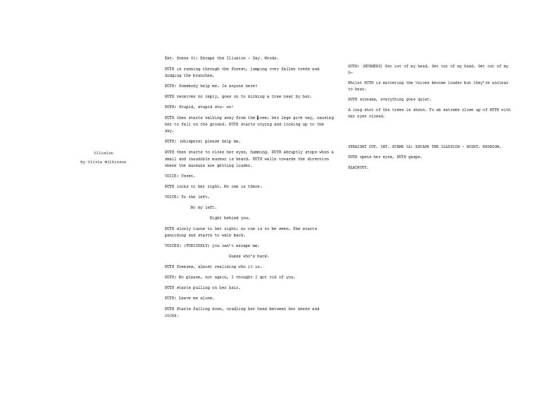
The link below is a presentation on the question: How the Cinematography is influenced by my textual analysis?
https://prezi.com/t0ltrfv8pp2w/how-the-cinematography-is-influenced-by-my-textual-analysis/
The link below is a presentation on the question: How the Sound is influenced by my chosen short films?
https://prezi.com/ywboqvwb2q7l/the-link-below-is-a-presentation-on-the-question/
The link below is a presentation on the question: How the mise en scene is influenced by my textual analysis and short films?
https://prezi.com/qcbjcwej6c9c/how-the-mise-en-scene-is-influenced-by-my-textual-analysis/
4. How successful was the artefact in achieving the aims?
In the end, I believe that my short film was rather successful to be sticking to the psychological thriller conventions, I believe that I have learnt a lot more by researching my focal films and watching the whole films in more depth, this helped me with my textual analysis. In the first place, I did understand the fact that my short film will not be a Hollywood hit film, this is due to it being my first proper film that I have directed, created a cast, edited and wrote, but it is also due to my film not being a budget film. My short films duration is 2 minutes and 2 seconds, which abids by the duration limit. In my opinion, i consider my sound to be my biggest strength, this is all because I followed through my research of the whole film of 6 Souls/Shelter, due to the scene just before the scene that I write about in my textual analysis, involves a large build up of non-diegetic sound of the voice overs, loud whispers which were used as a build up of tension as the cameras focal point was on the door, as it got closer to the door, the whispers were getting louder, this immediately made me consider that the sound and cinematography (camera movement) is allowing the audience to follow the narrative.
FEEDBACK:



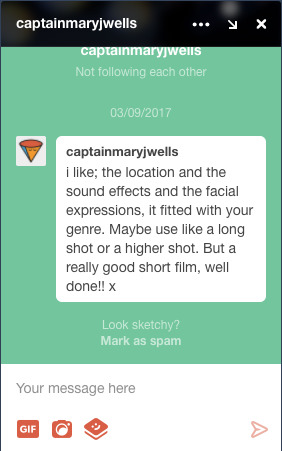
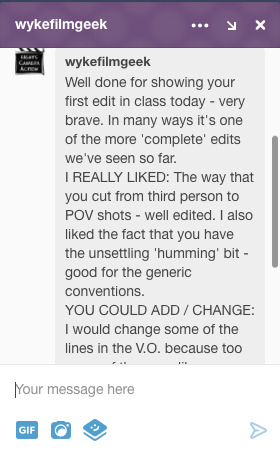
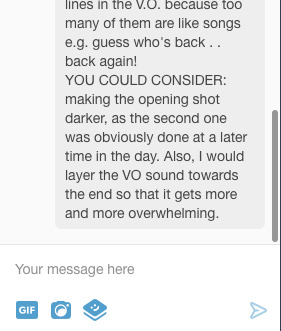

As I listened to my feedback for my first edit, I was hoping that it is clear for my audience to see the new improveents on my second and my final edit. These are most of my messages that held the improvements that I needed to do in my next filming session.
If I had the chance to improve my short film, I would want to think into more detail how my short film could involove more elements hat my focal films involved that I spoke about in my textual analysis. However, as I was writing my textual analysis I was considering the fact that I wanted to do a drama instead, this is because I thought it would have been much more easier for editing as I would not have to worry about the editing of sound, making my time schedual quicker rather than having to edit loads of different voices at a time, however, my overall conclusion came to the fact that I consider a psychological thriller, in my opinion more gripping, making the audience feel more apart of the film.
If I had to re-shoot, I would make my short film involve more high angle shots, this is mainly because my character felt more vulnrable, that is why I know there should not be any low angles, due to the character never having the triumph feeling. This helps the audience understand and feel more empathy for the character. I would also add more diegetic sound with the charcetr shouting help a lot more while she is running as it gives the scene more depth to the film, I would have also put non-diengetic sound of other people rather than just Callum Sholtysek, this is because my first idea for my film was to have a necklace in the woods and as she touched it, loads of voices from a woman was detected, they would have been more strong to show the womans authority, due to the impact the character - Ruth - would have fallen.
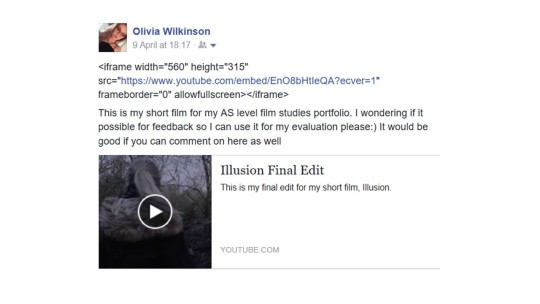


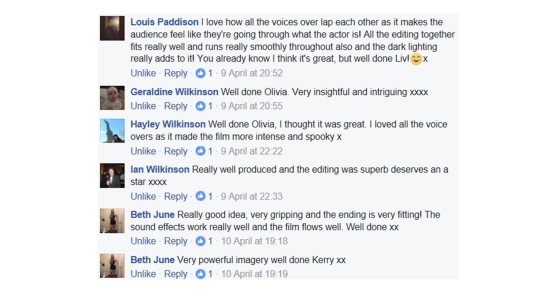
The screenshots above are feedback from the public on Facebook which is about my final edit, the feedback was uplifting as it started taking away my doubts about the film, as there are so many positive comments and no negative.
Directors Commentary:
This is my directors commentary, through my commentary I will be discussing how my short film uses the micro concepts, which are: Cinematography, sound, mise-en-scene and editing, and how they make my film fit in with the codes and conventions of a psychological thriller genre. I have linked within my two focal films: Orphan and 6 Souls/Shelter. But I have also linked with my short films.
youtube
1 note
·
View note